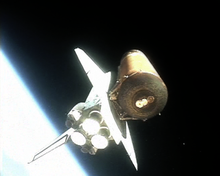
Back رحلة فضائية مدارية Arabic Vol espacial orbital Catalan فڕینی بۆشاییی خولگەیی CKB Orbitalflug German Vuelo espacial orbital Spanish پرواز فضایی مداری Persian Vol orbital French טיסה מסלולית HE Orbitalni let Croatian Orbitális repülés Hungarian
This article needs additional citations for verification. (March 2008) |

| Part of a series on |
| Spaceflight |
|---|
 |
|
|
An orbital spaceflight (or orbital flight) is a spaceflight in which a spacecraft is placed on a trajectory where it could remain in space for at least one orbit. To do this around the Earth, it must be on a free trajectory which has an altitude at perigee (altitude at closest approach) around 80 kilometers (50 mi); this is the boundary of space as defined by NASA, the US Air Force and the FAA. To remain in orbit at this altitude requires an orbital speed of ~7.8 km/s. Orbital speed is slower for higher orbits, but attaining them requires greater delta-v. The Fédération Aéronautique Internationale has established the Kármán line at an altitude of 100 km (62 mi) as a working definition for the boundary between aeronautics and astronautics. This is used because at an altitude of about 100 km (62 mi), as Theodore von Kármán calculated, a vehicle would have to travel faster than orbital velocity to derive sufficient aerodynamic lift from the atmosphere to support itself.[1]: 84 [2]
Due to atmospheric drag, the lowest altitude at which an object in a circular orbit can complete at least one full revolution without propulsion is approximately 150 kilometres (93 mi).
The expression "orbital spaceflight" is mostly used to distinguish from sub-orbital spaceflights, which are flights where the apogee of a spacecraft reaches space, but the perigee is too low.[3]
- ^ O'Leary, Beth Laura (2009). Darrin, Ann Garrison (ed.). Handbook of space engineering, archaeology, and heritage. Advances in engineering. CRC Press. ISBN 978-1-4200-8431-3.
- ^ "Where does space begin? – Aerospace Engineering, Aviation News, Salary, Jobs and Museums". Aerospace Engineering, Aviation News, Salary, Jobs and Museums. Archived from the original on 17 November 2015. Retrieved 10 November 2015.
- ^ February 2020, Adam Mann 10 (10 February 2020). "What's the difference between orbital and suborbital spaceflight?". Space.com. Archived from the original on 16 June 2020. Retrieved 13 July 2020.
{{cite web}}: CS1 maint: numeric names: authors list (link)